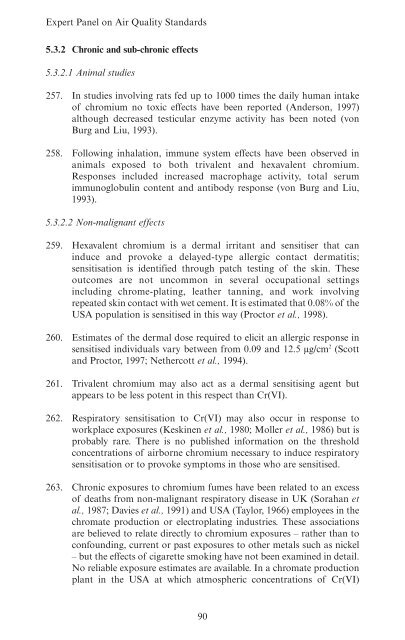Guidelines for Metals and Metalloids in Ambient ... - ARCHIVE: Defra
Guidelines for Metals and Metalloids in Ambient ... - ARCHIVE: Defra
Guidelines for Metals and Metalloids in Ambient ... - ARCHIVE: Defra
Create successful ePaper yourself
Turn your PDF publications into a flip-book with our unique Google optimized e-Paper software.
Expert Panel on Air Quality St<strong>and</strong>ards<br />
5.3.2 Chronic <strong>and</strong> sub-chronic effects<br />
5.3.2.1 Animal studies<br />
257. In studies <strong>in</strong>volv<strong>in</strong>g rats fed up to 1000 times the daily human <strong>in</strong>take<br />
of chromium no toxic effects have been reported (Anderson, 1997)<br />
although decreased testicular enzyme activity has been noted (von<br />
Burg <strong>and</strong> Liu, 1993).<br />
258. Follow<strong>in</strong>g <strong>in</strong>halation, immune system effects have been observed <strong>in</strong><br />
animals exposed to both trivalent <strong>and</strong> hexavalent chromium.<br />
Responses <strong>in</strong>cluded <strong>in</strong>creased macrophage activity, total serum<br />
immunoglobul<strong>in</strong> content <strong>and</strong> antibody response (von Burg <strong>and</strong> Liu,<br />
1993).<br />
5.3.2.2 Non-malignant effects<br />
259. Hexavalent chromium is a dermal irritant <strong>and</strong> sensitiser that can<br />
<strong>in</strong>duce <strong>and</strong> provoke a delayed-type allergic contact dermatitis;<br />
sensitisation is identified through patch test<strong>in</strong>g of the sk<strong>in</strong>. These<br />
outcomes are not uncommon <strong>in</strong> several occupational sett<strong>in</strong>gs<br />
<strong>in</strong>clud<strong>in</strong>g chrome-plat<strong>in</strong>g, leather tann<strong>in</strong>g, <strong>and</strong> work <strong>in</strong>volv<strong>in</strong>g<br />
repeated sk<strong>in</strong> contact with wet cement. It is estimated that 0.08% of the<br />
USA population is sensitised <strong>in</strong> this way (Proctor et al., 1998).<br />
260. Estimates of the dermal dose required to elicit an allergic response <strong>in</strong><br />
sensitised <strong>in</strong>dividuals vary between from 0.09 <strong>and</strong> 12.5 µg/cm 2 (Scott<br />
<strong>and</strong> Proctor, 1997; Nethercott et al., 1994).<br />
261. Trivalent chromium may also act as a dermal sensitis<strong>in</strong>g agent but<br />
appears to be less potent <strong>in</strong> this respect than Cr(VI).<br />
262. Respiratory sensitisation to Cr(VI) may also occur <strong>in</strong> response to<br />
workplace exposures (Kesk<strong>in</strong>en et al., 1980; Moller et al., 1986) but is<br />
probably rare. There is no published <strong>in</strong><strong>for</strong>mation on the threshold<br />
concentrations of airborne chromium necessary to <strong>in</strong>duce respiratory<br />
sensitisation or to provoke symptoms <strong>in</strong> those who are sensitised.<br />
263. Chronic exposures to chromium fumes have been related to an excess<br />
of deaths from non-malignant respiratory disease <strong>in</strong> UK (Sorahan et<br />
al., 1987; Davies et al., 1991) <strong>and</strong> USA (Taylor, 1966) employees <strong>in</strong> the<br />
chromate production or electroplat<strong>in</strong>g <strong>in</strong>dustries. These associations<br />
are believed to relate directly to chromium exposures – rather than to<br />
confound<strong>in</strong>g, current or past exposures to other metals such as nickel<br />
– but the effects of cigarette smok<strong>in</strong>g have not been exam<strong>in</strong>ed <strong>in</strong> detail.<br />
No reliable exposure estimates are available. In a chromate production<br />
plant <strong>in</strong> the USA at which atmospheric concentrations of Cr(VI)<br />
90
















